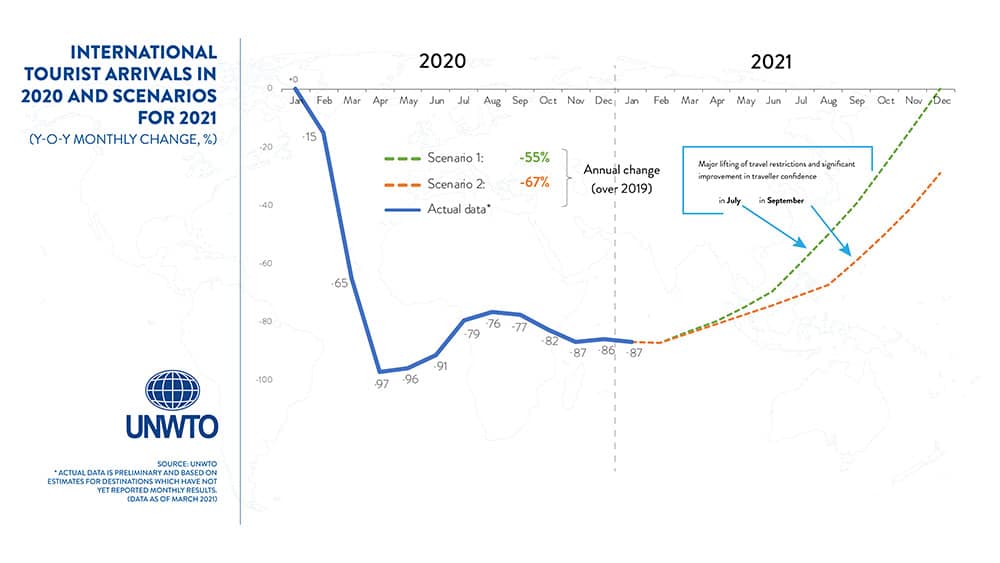
The devastating impact of the COVID-19 pandemic on global tourism has carried on into 2021, with new data showing an 87 per cent fall in international tourist arrivals in January as compared to 2020. The outlook for the rest of the year remain cautious as the World Tourism Organisation (UNWTO) continues to call for stronger coordination on travel protocols between countries to ensure the safe restart of tourism and avoid another year of massive losses for the sector.
Following a difficult end to 2020, global tourism suffered further setbacks in the beginning of the year as countries tightened travel restrictions in response to new virus outbreaks. According to the latest edition of the UNWTO World Tourism Barometer, all world regions continued to experience large drops in tourist arrivals in the first month of the year. Mandatory testing, quarantines, and in some cases the complete closure of borders, have all hindered the resumption of international travel. In addition, the speed and distribution of the vaccination roll-out have been slower than expected, further delaying the restart of tourism.
All global regions hit hard
Asia and the Pacific (-96 per cent), the region which continues to have the highest level of travel restrictions in place, recorded the largest decrease in international arrivals in January. Europe and Africa both saw a decline of 85 per cent in arrivals, while the Middle East recorded a drop of 84 per cent. International arrivals in the Americas decreased by 77 per cent in January, following somewhat better results in the last quarter of the year.
UNWTO Secretary-General Zurab Pololikashvili said: “2020 was the worst year on record for tourism. The international community needs to take strong and urgent action to ensure a brighter 2021. Many millions of livelihoods and businesses are depending on it. Improved coordination between countries and harmonized travel and health protocols are essential to restore confidence in tourism and allow international travel to resume safely ahead of the peak summer season in the northern hemisphere.”
The international community needs to take strong and urgent action to ensure a brighter 2021. Many millions of livelihoods and businesses are depending on it – Zurab Pololikashvili
Irish Tourism’s ‘Vertiginous Collapse’
The impact of Covid-19 on Ireland has been described by the Irish Tourism Industry Confederation (ITIC) has “vertiginous and shocking.” In 2019, tourism was Ireland’s largest indigenous industry and the biggest regional employer in the state. The ITIC calculates that revenue fell by 90 per cent in 2020 with 160,000 job losses in the sector. In its ‘Path Ahead’ recovery plan even the government – which has been heavily criticised by the sector for not responding more robustly to the impact of Covid on tourism – acknowledged that the tourism sector is the hardest-hit industry by the crisis.
Outlook for 2021
 With 32 per cent of all global destinations completely closed to international tourists at the beginning of February, UNWTO anticipates a challenging first few months of 2021 for global tourism.
With 32 per cent of all global destinations completely closed to international tourists at the beginning of February, UNWTO anticipates a challenging first few months of 2021 for global tourism.
Based on current trends, UNWTO expects international tourist arrivals to be down about 85 per cent in the first quarter of 2021 over the same period of 2019. This would represent a loss of some 260 million international arrivals when compared to pre-pandemic levels. Looking ahead, UNWTO has outlined two scenarios for 2021, which consider a possible rebound in international travel in the second half of the year. These are based on a number of factors, most notably a major lifting of travel restrictions, the success of vaccination programmes or the introduction of harmonized protocols such as the Digital Green Certificate planned by the European Commission.
The first scenario points to a rebound in July, which would result in a 66 per cent increase in international arrivals for the year 2021 compared to the historic lows of 2020. In this case, arrivals would still be 55 per cent below the levels recorded in 2019. The second scenario considers a potential rebound in September, leading to a 22 per cent increase in arrivals compared to last year. Still, this would be 67 per cent below the levels of 2019.
(Main photo by Matthew T Rader)




